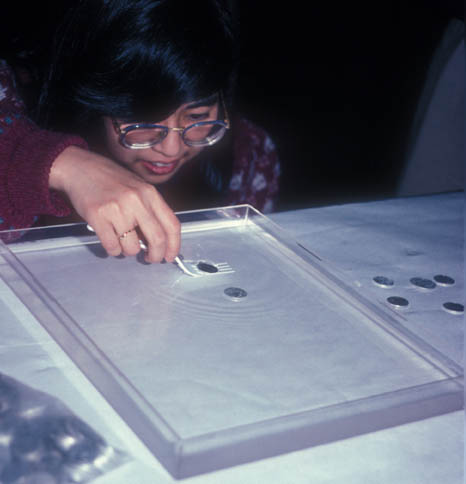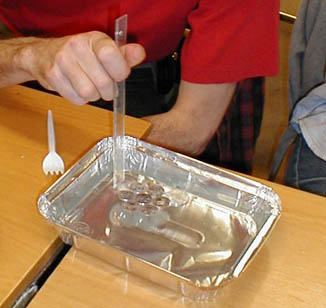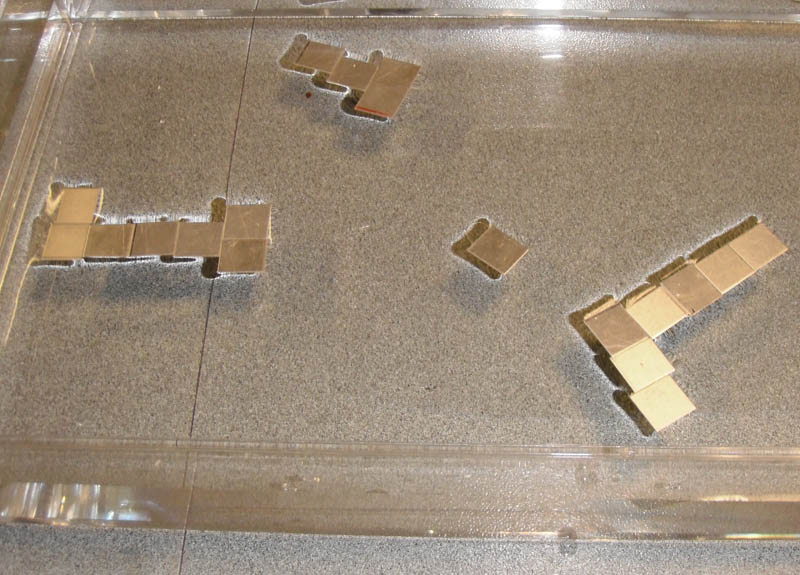Some countries allow their currency to float.

Concentration and a steady hand are needed to float aluminum coins on
water.
Some countries allow their currency to float.

Concentration and a steady hand are needed to float aluminum coins on
water.
Introduction
Aluminum coins can be "floated" on water. They are actually supported by surface tension. The coins will move together to form patterns. Circular coins and square "coins" form different patterns.
Material
A dozen or so aluminum coins, such as Japanese 1 yen coins,
Italian lire, French francs and more. (Available from coin stores
that advertise coins of the world, ask to see their junk
collection.)
You can also punch coins out of aluminum shim stock and cut square coins out of aluminum shim.
a tray of water, (larger than 15 cm x 15 cm, 6" x 6")
a plastic fork
To Do and Notice
Float an aluminum coin on water.
Hold the coin on the tines of the plastic fork, lower the coin onto
the surface of the water, be careful to keep the coin level. Tip the
tines of the fork into a vertical position and slip them up alongside
the coin and out of the water.
The coin must be dry to start.
Notice the depression in the surface of the water all around the edge
of the coin. It is easy to see the surface of the water by looking at
the reflection of a background pattern on the surface of the
water.
If the tray is clear look through the side to see how far the coin is
below the surface of the water.
Drip a drop of water on top of the coin, if the drop touches the
water at the edge of the coin, the coin will sink.
Float two coins on the water.
Notice that the coins move together as if they attract one another.
If the coins start out far apart the motion towards each other will
be very slow. The coins may also move toward the walls of the
container.
Float more coins. Notice how they come together to form regular
crystalline arrays.

Clear the tray and repeat the experiment with square coins.


Squares cluster into rectilinear patterns.
What’s Going On?
Water will not wet the aluminum coins. The surface of the water curves down toward the edge of each coin. The coins are thus supported by the surface tension of the water. (Aluminum is denser than water and will not float, if the coins are pushed under water they sink to the bottom.)
Two coins each depress the surface of the water. Picture two bowling balls on a trampoline. Each bowling ball rolls downhill into the valley created by the other ball. Alternatively picture two people on a soft bed, they tend to roll together. The coins each float downhill into the valley in the surface of the water created by the other coin. The coins appear to attract each other, but it is really their effect on the water surface that pushes them together.
If a third coin floats toward two that are already touching, it will reach its lowest energy position when it is touching both other coins forming an equilateral triangle. Additional coins will float toward and around a cluster of coins until they touch two coins creating a crystalline array of coins. If you float enough coins of the same size you will see the classic crystal pattern called hexagonal closest packed. If you look at one coin you will see that all of its nearest neighbors form a hexagon. If you look at a row of coins you will see that an adjacent row is shifted one-half a coin to the side so that each coin in this second row fits into the middle of the gaps between coins in the first row.
Shaking the container of water models higher temperatures. Vibration can bounce the coins far enough apart so that they come back together slowly. This models the melting of a solid. It is simpler to vibrate two coins apart than it is 3 coins. In the same way when water molecules come together to form a snow flake it is easy for the first couple of molecules to be shaken apart by thermal vibration. Thus it is difficult to begin the assembly of a snowflake. A seed crystal makes the initial assembly easier.
Another way to look at it
It takes energy to make a surface on water. Minimum energy requires minimum surface area.
Two cons touching have less surface area than two separated coins.
So there will exist a force which drives the coins together to the minimum energy configuration.
For square coins the minimum area occurs when two coins align with edges aligned as show in the 2 square image above.
Coins made of other metals are too dense to be floated on the surface tension layer of the water.
Larger aluminum coins are more difficult to float than small coins. If you double the size of a coin then its mass increases by a factor of eight while its circumference merely doubles. Since the weight is held up by surface tension which acts only along the circumference it becomes more difficult to float larger coins.
Etc
1. If you touch the surface of the water with soap the surface tension of the water will be decreased and the coin will be pulled away from the soap by the surface tension of the water on the other side or it will sink. Rubbing alcohol will also decrease the surface tension of water.
2. Large diameter aluminum coins must be made thicker to make it difficult to bend them.
3. A tray with a clear bottom will allow you to use an overhead projector to show the floating coins to a large class.
4. If you poke the surface of the water near a floating coin with an object the coin may move toward or away from that object. If water wets the object and climbs up its side making a hill, the coin will move away. If water doesn't wet the object, a hole will be created, and the coin will move toward the object.
|
Scientific Explorations with Paul Doherty |
|
26 October 2010 |